In our last post we explained the types of marginal notes that were included in the 1611 KJV. A fun quiz testing knowledge of those notes can be taken here. We gave special attention to listing and explaining the marginal notes that related to NT textual criticism. Not everyone felt that such notes were needed, or helpful. Some feared they would cast doubt on the authority of Scripture. So here, we take up the KJV Translators’ own defense of their marginal notes, and break down what they said about them, and why they felt that they were necessary.
The Translators’ Defense Of Marginal Notes
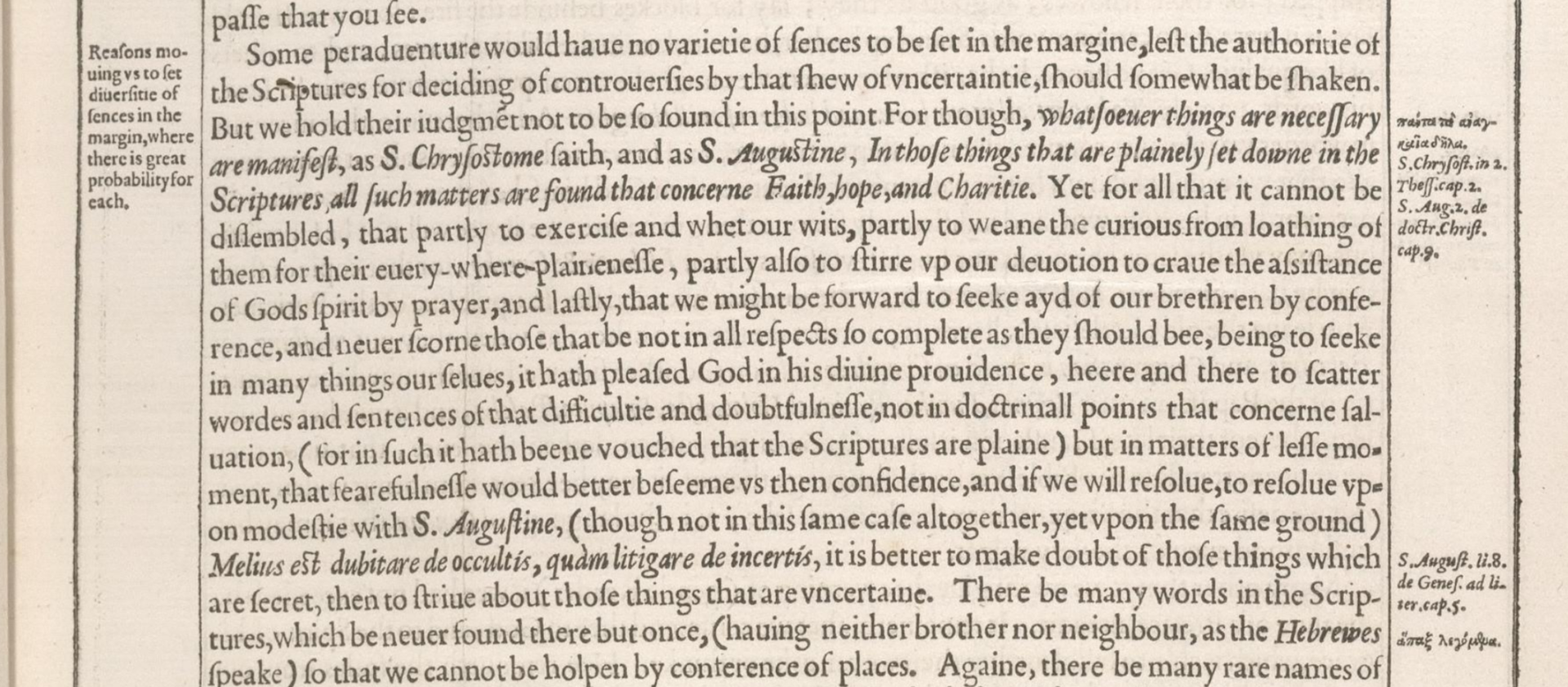
In the third and final stage of preparing the King James Bible, Miles Smith penned the prefatory The Translators To The Reader included in the front matter of the King James Bible of 1611. While Smith penned the work, it clearly intends to set out the attitudes of the Translators as a whole (insofar as there could be unity between members of such a diverse group). In one of the final sections of this Preface, the Translators defended their use of marginal notes, under the marginal heading, “Reasons moving us to set diversity of senses in the margin, where there is great probability for each” (David Norton, Ed., The New Cambridge Paragraph Bible with the Apocrypha: King James Version, Revised edition., Cambridge, UK: Cambridge University Press, 2011, preface contained on pages xxxii-xxxiv). That Preface has been included in David Norton’s New Cambridge Paragraph Bible (described in the video below, by Mark Ward here, and by the editor in an interview now only available in the archive here). A modern summarized paraphrase of the Preface has been helpfully created by Mark Ward here. One of the best reprints of the Preface is that by Rhodes and Lupas here. After a helpful introduction to the Preface, they print the preface in three different forms; the original, in a photographic facsimile, a modern spelling reprint, and a modern English rendering. They also explain obscure references and translate Greek, Hebrew, and Latin phrases.
The Translators first raised the objection in their Preface that providing alternate translations in the margins would threaten the authority of Scripture. The fear on the surface seems reasonable. If the reader can “choose” translations, then the Bible isn’t really the final authority – right? If we give the reader a choice, then he becomes the authority – doesn’t he? Does uncertainty shake the authority of Scripture? They raised the objection; “Some peradventure would have no variety of senses to be set in the margin, lest the authority of the Scriptures for deciding of controversies by that show of uncertainty should somewhat be shaken.” They then decidedly disagreed; “But we hold their judgment not to be so be so sound in this point.” This is the textual absolutist framework that appeared earlier in the preface, simply in different dress. To suppose that the reader must be equally certain about every part of the biblical text is the same “all or nothing” approach to which they had previously objected. They wanted their translation to present uncertainty at some points for a simple reason – the text is uncertain at some points. They pointed out that historically, Christianity has maintained that the Bible speaks clearly in matters of faith and Christian practice (what they referred to here as “hope, charity, and salvation”). Thus, salvation is clearly witnessed to in Scripture. But the corollary some would build from this, that since the Bible is all equally the Word of God, we must have equal certainty about it in every place, did not follow in their minds.
A Complex Sentence
The next sentence, in which they refuted this idea, can appear somewhat convoluted, and this is possibly intentional. It is easily one of the most complex sentences in the entire Preface. Rhodes and Lupas paraphrased it into three separate sentences. It argues against the corollary they had just mentioned. The necessary things are plainly manifest, but “…it cannot be dissembled that…it hath pleased God…here and there to scatter words and sentences of that difficulty and doubtfulness…that fearfulness would better beseem us than confidence…[viz., we are certain of uncertainty, and thus say, with St. Augustine, that] it is better to make doubt of those things which are secret, than to strive about those things that are uncertain.” I give the sentence here as Norton has it;
For though ‘whatsoever things are necessary are manifest’, as St Chrysostom saith,1 and as St Augustine, ‘In those things that are plainly set down in the Scriptures all such matters are found that concern faith, hope, and charity’:2 yet for all that it cannot be dissembled that partly to exercise and whet our wits, partly to wean the curious from loathing of them for their everywhere plainness, partly also to stir up our devotion to crave the assistance of God’s Spirit by prayer, and lastly, that we might be forward to seek aid of our brethren by conference, and never scorn those that be not in all respects so complete as they should be, being to seek in many things ourselves, it hath pleased God in his divine providence here and there to scatter words and sentences of that difficulty and doubtfulness, not in doctrinal points that concern salvation (for in such it hath been vouched that the Scriptures are plain), but in matters of less moment, that fearfulness would better beseem us than confidence, and if we will resolve, to resolve upon modesty with St Augustine (though not in this same case altogether, yet upon the same ground), ‘Melius est dubitare de occultis, quam litigare de incertis’:3 it is better to make doubt of those things which are secret than to strive about those things that are uncertain.
____
1 Πάντα τὰ ἀναγκαῖα δῆλα. St John Chrysostom, In Epistolam II ad Thessalonicenses 2, Homilia 3 (PG 62:485).
2 St Augustine, De Doctrina Christiana, 2:9:14 (CC 32:41; PL 34:42).
3 St Augustine, De Genesi ad Litteram, 8:5 (PL 34:376).
– David Norton, Ed., The New Cambridge Paragraph Bible with the Apocrypha: King James Version, Revised edition., (Cambridge, UK: Cambridge University Press, 2011), pg. xxxiii.
They marshaled Augustine and Chrysostom to make the point; “For though ‘whatsoever things are necessary are manifest’, as St Chrysostom saith, and as St Augustine, ‘In those things that are plainly set down in the Scriptures all such matters are found that concern faith, hope, and charity.’” The “necessary” things (the essentials, the doctrinal points important to “salvation”) are clearly “manifest” and “plainly set down.” The essentials of the faith are not in dispute due to ambiguity of translation or textual uncertainty. But this does not mean that all of Scripture is thus without such uncertainty. In fact, God has scattered throughout Scripture passages that are “of difficulty.” Some passages are hard to interpret or translate with any conviction. Translation can at times feel like the toss of a coin between various options.
[The marginal notes in the KJB] are a constant reminder both that translation is an inexact process and that the original texts are sometimes uncertain or obscure.
– David Norton
Further, God has allowed there to be here and there scattered passages of “doubtfulness.” Here they were perhaps referring to the form of the original text being in dispute at points. They were well aware that there are textual variants where the precise wording of the originals is in some dispute. As we demonstrated at length in the last post, they noted dozens of these variants in the margins of their text. God has allowed these things to be so, and this “cannot be dissembled [hidden].” Before we look at this sentence, we should look closer at this question of whether or not they reference text-critical issues here in the Preface.
Textual Criticism In The Preface?
Interestingly, Bancroft’s rules for the Translators would seem on the surface to prohibit the practice of raising doubts in marginal notes. His sixth rule had stated directly, “No marginal notes at all to be affixed, but only for the explanation of the Hebrew or Greek words, which cannot without some circumlocution so briefly and fitly be expressed in the text.” This was a concern raised by the King himself at the Hampton Court Conference in 1604. The all-too enthusiastic agreement of the King to the suggestion of John Reynolds for a new translation had hardly left his lips before he added a caveat aimed at what he thought were the dangerous concessions to treason in some of the Geneva notes. In the words of William Barlow, a Translator present at the conference;
…Marry, withal, he gave this caveat (upon a word cast out by my Lord of London) that no marginal notes should be added, having found in them, which are annexed to the Geneva translation (which he saw in a Bible given him by an English Lady) some notes very partial, untrue, seditious, and savoring too much, of dangerous, and traitorous conceits: As for example, Exod. 1. 19. where the marginal note alloweth disobedience to Kings. And 2. Chron. 15. 16. the note taxeth Asa for deposing his mother, only, and not killing her…
– William Barlow, The Svmme and Svbstance of the Conference… Early English books online, spelling modernized, (London: imprinted by Iohn Windet and T. Creede for Mathew Law, and are to be sold at his shop in Paules Churchyeard, neare S. Austens Gate, 1604), pg. 46–47.
Yet they seemed to have interpreted his rules to allow for the addressing of at least some text-critical issues. Thus, when the rules were summarized to the Synod of Dort in 1618 on Nov. 20th, Tuesday, a little before noon (in a paraphrased form), one Translator, Samuel Ward, explained several of them and their relation to the varia lectio (variant readings) as follows,
Secondly, no notes were to be placed in the margin, but only parallel passages to be noted. Thirdly, where a Hebrew or Greek word admits two meanings of a suitable kind, the one was to be expressed in the text, the other in the margin. The same to be done where a different reading [textual variant] was found in good copies [manuscripts].
– A. W. Pollard, Records of the English Bible, pg. 339. (See the new critical edition of the Acta here).
While perhaps technically violating Bancroft’s rule by adding notes about textual variants, they clearly broadly interpreted the rule to allow it in at least some cases. Precisely because the summary at Dort specifically mentioned textual variants (and because, as we demonstrated in our last post, they directly raised text-critical issues in their marginal notes), we should expect that in at least some of their statements in this section of the Preface about marginal notes they had in mind both translation difficulties and textual doubts. It is in fact possible that they referred to both, respectively, when they referred to passages of “difficulty” and “doubtfulness” (note for example the regular use of the word in later discussion of textual variants in relation to the Thirty-Nine Articles which expressed the Translators’ own theology).
David Norton suggestively hints at how the marginal notes encourage recognition of textual uncertainty. In the brief section where he treats the marginal notes and how they were handled in the NCPB, he explains that the margin contained, “alternative translations or readings in the original [emphasis mine],” and that the marginal notes, “are a constant reminder both that translation is an inexact process and that the original texts are sometimes uncertain [emphasis mine] or obscure” (David Norton, A Textual History Of The King James Bible, pg. 163). Rhodes and Lupas, while not addressing the issue at length, seem to assume that text-critical issues are in view in this part of the Preface. In the few sentences where they summarize this and the next section of the Preface in their introduction, which address two matters of editorial policy, they explain;
The first concerned the use of marginal notes where there is uncertainty about the wording of the original text [emphasis mine] or about its interpretation. The translators were aware that some persons might fear that such notes would bring into question the authority of the Scriptures, but they were convinced that such notes are necessary. They argued that “God had been pleased in his divine providence to scatter here and there words and sentences that are difficult and ambiguous, [which] do not touch on doctrinal points that have to do with salvation, but on matters of less importance,” and that in such instances “we should be diffident rather than confident, and if we must make a choice, choose modesty with St. Augustine, who recognized that, ‘It is better to be reserved about things which are not revealed, than to fight about things that are uncertain.’ “
– Rhodes and Lupas, The Translators To The Reader, pg. 3
It would seem then that what the Translators say in this section of the Preface dedicated to marginal notes applies not only to areas of difficulty in translation, but also to those of text-critical uncertainty, or textual doubt. That is, we are reading here the philosophy of the Translators both as translators and as textual critics.
What God Did
To move on to their complex sentence, we note that there are three basic parts to this complex sentence; first, why God has done what he did, second, what He did, and third, the results of Him having done what He did. We note first from the end of the sentence what it is that God has done that they wished to both defend and honor. What did he do? He scattered “words and sentences of that difficulty and doubtfulness” throughout Scripture. Note that they referred specifically both to individual words, as well as to sentences. It is not just an occasional word in isolation about which they were unsure (a conclusion the less-than-careful reader might deduce from their illustrations below). Sometimes it was whole sentences. They immediately qualified that none of these translation difficulties or textual doubts about words and sentences affected doctrine or salvation, but were about “matters of less moment.” Yet they refused to hide the fact that God had done this. It “cannot be dissembled” [hidden or concealed].
Why God Did It
But why did God do this? Why did he leave things uncertain? They provided four purpose clauses giving partial reasons to explain why God has so acted. First, “to exercise and whet our wits.” God gave us brains, and meant for us to use them. Difficulties in text and translation can stir up the curious and give them a desire to dig deeper into Scripture. Second, “to wean the curious from loathing of them for their everywhere plainness.” “Curious” is used in its obsolete sense here meaning, “expert” (OED, A.I.4.). God doesn’t want the sophisticated “experts” to loathe the Scriptures for being too simplistic and plain, so he has weaned them from this folly by placing difficulties and doubts within them. Third, to “stir up our devotion to crave the assistance of God’s Spirit by prayer.” Difficulties and doubts in the text of Scripture force us to rely on God’s Spirit in prayer, rather than our own abilities of understanding.
The fourth purpose clause is somewhat more complex. Fourth (and “lastly”), God did this to humble us. They express this humbling motive as showing itself in two practical results, which are intended to balance against each other. The first is that because of such difficulties in Scripture, we must humble ourselves and seek help from others by discussing Scripture with them. God so acted that we might, “be forward to seek aid of our brethren by conference.” The KJV Translators were convinced that no one should interpret the Bible in isolation from the community of faith. In fact, they were convinced, sometimes we even need the help of scholars to read the Bible well. And we must discuss Scripture, not just read and preach it. Bible readers need help, even from scholars and scholarly discussion.
But the second clause balanced this thought. On the one hand God has humbled the average reader, who needs the scholar. But he has also humbled the scholar. Thus, the second result humbled them that they, “might…never scorn those that be not in all respects so complete as they should be, being to seek in many things” themselves. That is, scholars can’t look down on those unlearned (who are “not in all respects so complete as they should be”). The difficulties of Scripture which they cannot definitively solve constantly remind them that scholars too are ignorant in many areas. Even scholars don’t know everything. All alike stand humbled before the Bible.
The KJV Translators were convinced that no one should interpret the Bible in isolation from the community of faith. In fact, they were convinced, sometimes we even need scholars.
The Results Of What God Did
Having taken up the what and the why of what God indisputably did, they then explained the results of what He did. The entire last section of the sentence, beginning with “that fearfulness…,” explains the end result of God’s action, and their required response to it, which is the whole point of the sentence. The result of God’s action is, “that fearfulness would better beseem us than confidence.” In places of translation difficulty and textual doubt, they refused to speak with unwarranted confidence. Having a text, without a margin, might give the appearance that they had a certainty about the text that they didn’t have. They want to be especially careful not to miscommunicate at this point. The truth is, they weren’t sure in many places which reading or translation to adopt. As their heading to this section made clear, “there is good probability for each.” Thus, they refused to make a firm choice between the two. In fact, they note that if they “will resolve [make a firm choice],” they will make only one such choice; “to resolve upon modesty…” They chose to remain uncertain.
They took as a model in this regard St. Augustine. As they “resolved” to be uncertain, they resolved so, “with St. Augustine.” They supported this with a quote from his unfinished work, On the Literal Interpretation of Genesis, though noting that he is speaking in a different context (difficult interpretation of a hard passage, not difficult translation or textual variation). Nevertheless, he spoke, “upon the same ground,” so they quoted him, and translate his words, with which they so agree. For, “it is better to make doubt of those things which are secret, then to strive about those things that are uncertain.” About some passages they were not sure of the text or the translation. In harmony with Augustine, they explicitly wanted their marginal notes to “make doubt” about such places.
…it is better to make doubt of those things which are secret, then to strive about those things that are uncertain..
– St. Augustine
Two Illustrations
They then provided two illustrations of this point. It is interesting to note the kind of illustrations they chose. It is clear by their statements in this sentence, as well as the later sentences under this heading, that they referred to alternate readings, both of textual doubt and translation difficulty. Their summary to the Synod of Dort quoted above makes this even more clear. They referred specifically in the sentence just looked at to words and “sentences.” But in the two illustrations they provided of their practice, they mentioned only individual words, and only of the kind that might be regarded as the least significant of their notes. It is easy to get the impression that they were intentionally downplaying the scope of their marginal doubts.
Their first illustration was from the phenomenon known as “hapax legomenon,” or “words that be used only once.” They printed the Greek phrase in the margin here. While counts vary slightly by method and text, there are something like 686 of these in the Greek NT, and some 1,500 of them in the Hebrew OT (though only about 400 of these Hebrew words don’t have some relation to one another). These words pose a special difficulty for translators, because they typically determine what a word means by examining how it is used in different contexts, by different authors. When a word occurs only once, we have no other examples of its usage in the text (which the Translators referred to as the word, “having neither brother nor neighbor”).
Interestingly, these words were a much greater challenge to Greek translators in 1611 than they are today, as were many linguistic elements. In the early 17th century, many scholars thought that the Greek language of the NT was an entirely different language than the Greek of its own time, sometimes called, “Holy Ghost Greek.” One of the reasons for this was the high number of words used only in the NT, and so many used only once. However, we later discovered thousands of papyri from the same era, and Adolf Deissmann published his magisterial work, “Bible Studies” in 1895, showing by comparison of these thousands of papyri with the NT that this entire idea was flawed. The language in which the NT was written was not a unique language invented by the Holy Ghost specifically for biblical revelation; it was the common language of the everyday man. Nonetheless, such words, though much better understood today, were a great challenge to translators of the NT in the early 17th century. This is why the Translators noted that, “There be many words in the Scriptures, which be never found there but once, (having neither brother nor neighbor, as the Hebrews speak) so that we cannot be helped by conference of places.”
Their second illustration came from zoology and geology. In many cases, they just didn’t know what animal, precious stone, etc., was being referred to in a particular biblical text. Many ancient commentators were not particularly helpful, as they often said something with a show of certainty, but without the knowledge to back it up. While we have much advanced today in our understanding of geology and zoology in the biblical references, there was a great ignorance of such subjects in 1611. The Translators admitted this, and mentioned the specific problem this posed for them as Translators. They noted, “Again, there be many rare names of certain birds, beasts and precious stones, etc. concerning which the Hebrews themselves are so divided among themselves for judgment, that they may seem to have defined this or that, rather because they would say something, than because they were sure of that which they said, as S. Jerome somewhere saith of the Septuagint.” It is noteworthy again that both of the illustrations of marginal notes given by the Translators here (hapax legomenon and an admitted ignorance of natural history) make up only a small section, and perhaps the most insignificant section, of the marginal notes which they actually included with the text of the 1611.
Avoiding Presumption
Having given two illustrations (of the actually much broader) types of marginal notes they employed, the Translators then made their point, and explained their logic. They noted, “Now in such a case, doth not a margin do well to admonish the Reader to seek further, and not to conclude or dogmatize upon this or that peremptorily?” When one is not sure what they text says, or what the text means, it would be dishonest for the reader to draw a conclusion based on the Translators’ fallible translation peremptorily. It would be better that they not “conclude” or “dogmatize” upon the translation difficulties and textual doubts. Note that they presumed the presence of error in their work here. If they had felt that they had not made errors, it would not be preemptory to conclude and dogmatize, and there would be no need for the reader to “seek further.”
They then explained the reason why this was so. They clearly had in mind the broader type of notes they typically include, rather than just those relating to zoology, geology, and hapax legomenon; “For as it is a fault of incredulity, to doubt of those things that are evident: so to determine of such things as the Spirit of God hath left (even in the judgment of the judicious) questionable, can be no less then presumption.” When God has spoken clearly, and there are no difficulties of translation, and no textual uncertainties about what he said, it would be a sin to fail to believe what God said. It would be unwarranted incredulity, a blatant unwillingness to believe God. But in the same way, in some places the Spirit of God has left the meaning/translation of a text, or its textual veracity, “questionable.” In such cases to “determine;” to conclude or dogmatize; to speak with certainty when we simply don’t have certainty, is, “no less than presumption.” Where God has not given us certainty, it is presumption to pretend (or demand) that we have it.
…to determine of such things as the Spirit of God hath left (even in the judgement of the judicious) questionable, can be no less than presumption.
– KJV Translators
Augustine On The Wisdom Of Uncertainty
They then noted Augustine’s wise words to the same effect, directly applying their thought finally to the addition of marginal notes; “Therefore as S. Augustine saith, that variety of Translations is profitable for the finding out of the sense of the Scriptures: so diversity of signification and sense in the margin, where the text is not so clear, must needs do good, yea is necessary, as we are persuaded.” Augustine knew that there is no perfect way to translate much of Scripture. He had suggested that the wise reader always compare different translations to make sure that he understands the sense of Scripture, not just the interpretation of the translator. Our Translators quite agreed.
It is worth examining Augustine’s context and statement in more depth, since they assumed more knowledge of it than most readers today have. Augustine in his, On Christian Doctrine, explained the ambiguity of signs and idioms. He suggested that one thing that can help a student is to compare multiple different translations. He was not talking about marginal notes of course, but diverse Latin translations of the biblical text. The best thing one can do is to learn the languages. But if a student can’t do this, he should at least compare multiple translations;
About ambiguous signs, however, I shall speak afterwards. I am treating at present of unknown signs, of which, as far as the words are concerned, there are two kinds, For either a word or an idiom, of which the reader is ignorant, brings him to a stop. Now if these belong to foreign tongues, we must either make inquiry about them from men who speak those tongues, or if we have leisure we must learn the tongues ourselves, or we must consult and compare several translators… So great, however, is the force of custom, even in regard to learning, that those who have been in a sort of way nurtured and brought up on the study of Holy Scripture, are surprised at other forms of speech, and think them less pure Latin than those which they have learnt from Scripture, but which are not to be found in Latin authors. In this matter, too, the great number of the translators proves a very great assistance, if they are examined and discussed with a careful comparison of their texts. Only all positive error must be removed. For those who are anxious to know, the Scriptures ought in the first place to use their skill in the correction of the texts, so that the uncorrected ones should give way to the corrected, at least when they are copies of the same translation.
– Augustine of Hippo, St. Augustin’s City of God and Christian Doctrine, 1887, 2, pg. 542.
The Translators have made a strong case to say that when the text is not clear, a marginal note to “make doubt” is the honest way. However, they may have spoken somewhat facetiously here. They by no means notated all of the translation difficulties of which they were aware. And they touched only the tip of the iceberg of the textual doubts that they were aware of, versus what they noted in the margin. In Erasmus’ 1516 edition of the NT alone there were 1000 + annotations (by his own count), many of which dealt with textual variants. There were at least as many in the 1598 edition of Beza that they employed. Almost none of these made their way into the margins of the KJV. In the notes of John Bois, which reflect only one stage of the work, there are multiple textual variants dealt with or mentioned that did not end up in a marginal note. I suspect they noted what they could, perhaps limited somewhat by Archbishop Bancroft’s rule about marginal notes. We might guess that had they notated all places where they were unsure about the text or its translation, their notes could have overtaken the Geneva Bible for scope, and the King and Bancroft might even have censured them and their work. They also probably had little interest in giving great attention to text-critical issues, as the age as whole was less concerned with NTTC until Mills in 1707.
…variety of Translations is profitable for the finding out of the sense of the Scriptures…
– St. Augustine
Conclusion – Wisdom Refuses to Dogmatize In Areas Of Uncertainty
They concluded this section with a note about Pope Sixtus V, and their disagreements, showcasing again the Protestant nature of their work. Sixtus had commanded that no marginal notes (and no Latin textual variants) be notated in the printed edition of the Latin Vulgate. They noted that the comparison is not identical, because his statement was about the Vulgate, but it is similar. For, “We know that Sixtus Quintus expressly forbiddeth that any variety of readings of their Vulgar edition should be put in the margin (which though it be not altogether the same thing to that we have in hand, yet it looketh that way), but we think he hath not all of his own side his favourers for this conceit.” Even Catholics did not agree with such a decision, as Erasmus and Valla had shown. They had produced in their editions of the Latin Vulgate notes about textual variants and translational difficulties. If the Pope could truly have spoken ex cathedra as claimed, he of course could have given a final word about all translation difficulties and textual variants. “If they were sure that their high priest had all laws shut up in his breast, as Paul the second bragged, and that he were as free from error by special privilege as the dictators of Rome were made by law inviolable, it were another matter; then his word were an oracle, his opinion a decision.” But they knew this to be only a myth, and they were grateful to God that the Reformation had opened men’s eyes to such nonsense. The Pope is a fallible man – he bleeds. “But the eyes of the world are now open, God be thanked, and have been a great while; they find that he [the Pope] is subject to the same affections and infirmities that others be, that his skin is penetrable, and therefore so much as he proveth, not as much as he claimeth, they grant and embrace.”
They that are wise had rather have their judgements at liberty in differences of readings than to be captivated to one, when it may be the other.
– KJV Translators
The Translators’ concluding thought (if not the exact last words) of this section are, “They that are wise, had rather have their judgments at liberty in differences of readings, then to be captivated to one, when it may be the other.” If there is uncertainty, it is the greater part of wisdom to leave the reader’s judgment at liberty. This is better than to be captivated to one translation, or one decision about a textual variant of alternate translation, when it may well be the other. Their wisdom of respecting the difficulties and uncertainties of Scripture remains a model for all translators today.
Addendum:
I have mostly shared the slightly modernized form of this section of the Preface from Norton’s NCPB above. Yet some do not like any modernization, while others would prefer more. In the interest of objectivity, the original 1611 section, with no modernization, can be viewed here, on page 15. On Kindle with original spelling it can be found here. And I quote here the full paragraph in the modern English rendering by Rhodes and Lupas. I might quibble at a few points, but for those who find the archaic English hard to get through, this might be helpful. And it’s only fair that the reader see a slightly different handling than I have given above. They render the section as follows;
Reasons for placing in the margin alternative readings having a claim to authenticity
Some persons perhaps would want to have no alternative readings or renderings placed in the margin, for fear that any appearance of uncertainty might undermine the authority of Scripture as definitive. But we do not consider their judgment to be prudent on this point. It is true that “everything that is necessary is obvious,” as St. Chrysostom says, and as St. Augustine says, “the things that are stated clearly in the Scriptures include everything having to do with faith, hope, and love.” And yet the fact cannot be disguised that partly in order to keep us alert and make us use our intelligence, partly to keep sophisticated people from looking down on the Scriptures as too simple for them, partly also to encourage us to pray for the assistance of God’s Spirit, and finally, to make us look actively to our brethren for help through discussion (not looking down on people who are not as educated as they might be, since we too are ignorant in many areas), God has been pleased in his divine Providence to scatter here and there words and sentences that are difficult and ambiguous. These do not touch on doctrinal points that have to do with salvation (because we know that in these the Scriptures are clear), but on matters of less importance. Therefore we should be diffident rather than confident, and if we must make a choice, to choose modesty as did St. Augustine, who said about a situation that was similar though not identical, “It is better to be reserved about things which are not revealed, than to fight about things that are uncertain.” There are many words in the Scriptures which are found there only once (with neither brother nor neighbor, as the Hebrews say) so that help cannot be gained by comparing passages. Again, there are many rare names for birds, animals, and gems, etc., which the Hebrews themselves are so uncertain about that they seem to have defined them one way or another, more because they wanted to say something, than because they were sure of what they said, as St. Jerome says somewhere about the Septuagint. In such cases a marginal note is useful to advise the Reader to seek further, and not to draw inferences or dogmatize rashly about this or that. For if it is the fault of incredulity to doubt what is evident, it can be no less than presumption to be definite about things that the Spirit of God has left (even in the judgment of the judicious) questionable. Therefore as St. Augustine says that alternative translations are profitable for finding out the meaning of Scriptures, so also we believe that alternative readings in a marginal note, where the text is not clear, must not only be good but even necessary. We know that Sixtus V specifically forbids any alternative readings to be put in the margin of their Vulgate edition (and although this is not precisely what we are discussing here, it is close), yet not all of his colleagues are in agreement with him in this. The wise would prefer a freedom of choice where there are differences of readings, rather than be restricted to one when there is an alternative. It would be different if they were made legally inviolate. Then his word would be an oracle, and his opinion a decision. But the eyes of the world are open now, God be thanked, and they have been a great while. They find that he is subject to the same feelings and weaknesses that others are, that he is human. Therefore they will recognize and accept only what he proves, not everything he claims.
– The Translators to the Reader: The Original Preface of the King James Version of 1611 Revisited, edited by Erroll F. Rhodes, and Liana Lupas, American Bible Society (November 1, 2000).
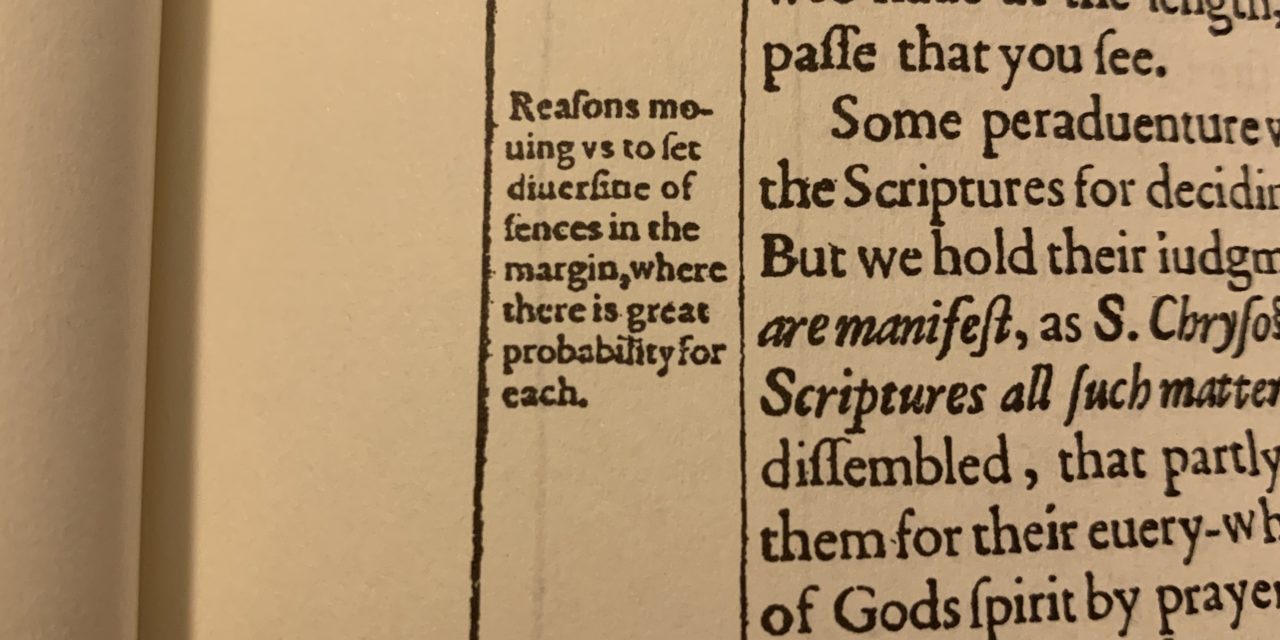
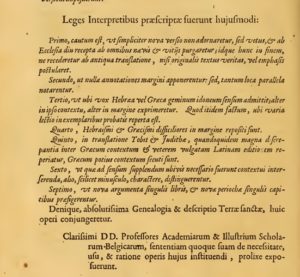

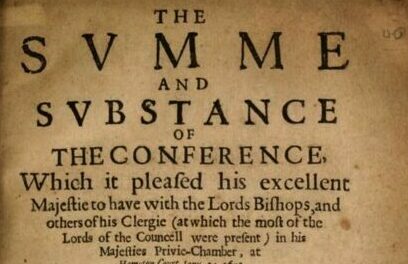
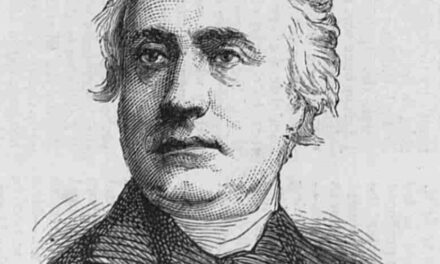


Comments